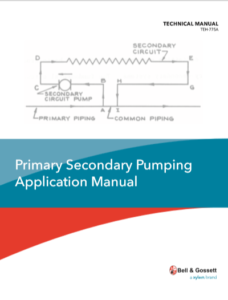 Correction to my 8-26-19 blog. In the rush to get on vacation I messed up on my math. This is corrected. Thank you to Tom at Hydro-Flo in Wisconsin for bringing it to my attention. Hydronic system hot water coils in air handling units (AHU) often have secondary pumps for freeze protection. The hot water coils usually have design temperatures that are the same as the boiler temperatures. Since we are installing a pump as part of the design, why not save a thousand or more dollars in yearly energy costs. How can you do that?
Correction to my 8-26-19 blog. In the rush to get on vacation I messed up on my math. This is corrected. Thank you to Tom at Hydro-Flo in Wisconsin for bringing it to my attention. Hydronic system hot water coils in air handling units (AHU) often have secondary pumps for freeze protection. The hot water coils usually have design temperatures that are the same as the boiler temperatures. Since we are installing a pump as part of the design, why not save a thousand or more dollars in yearly energy costs. How can you do that?
Changing the Supply and Return Temperatures in AHU Units
The last two R. L. Deppmann Monday Morning Minutes provided the basic rules for primary secondary piping and design. We showed how to use the primary-secondary system to provide the reduced temperature needed for radiant heating design. The same design can be used to provide lower return temperatures to the hydronic heating condensing boilers.
An example of a typical hot water AHU coil piping is shown below. This example will use a water coil requiring 50 GPM with a supply temperature of 180°F and a return of 140°F. A very standard design we see every day.

The return temperature to the boilers will be 140°F. How can we get that temperature lower so the boilers can condense during more of the season? The first thing is to change the temperatures in the coil. Let’s look at the numbers if we change the hot water coil to a 150°F supply and a 110°F return. This keeps the delta T at 40°F but changes the average temperature from 160°F to 130°F. The coil will require more heat transfer surface and I’ll address that below. Here is the design for the coil primary-secondary system.
SECONDARY SIDE: 50 GPM X (150-110) X 500 = 1,000,000
PRIMARY SIDE: 1,000,000/ ((180-110) X 500) = 29 GPM
The new system will look like this.

What are the pros and cons of this change? Well, the only negative is the additional cost of the coil. I called our friends at the Trane Company and asked for the impact. The 180°F coil will be a series D3WB with 2 rows. The 150°F coil is a DW0B with 3 rows. If there were 4 of these AHU units, the cost impact will be about $3,000 each or $12,000 total additional first cost. Why spend $12,000 more?
Cost Savings when using Lower Temperature AHU Coils
There are two ways we are saving money with the new temperature range. One way is energy savings. The second is “first cost” piping changes. In our example, we are dropping the design flow and head from 200 GPM at 40 feet to 116 GPM at 40 feet. This will change the pumps from base mounted end suction to inline and severely reduce the horsepower. We will assume both systems are the variable speed with a 40-foot head. The 200 GPM system is 4” and the 116 GPM is 3” and we’ll use 500 feet of pipe length.
The net, first cost savings in equipment and installation is about $4,600. This includes reduced equipment prices as well as labor. Obviously this changes with the complexity of the project and the labor rate, but this is close enough for this blog. I included some money for the additional piping to the lower connection of an Aerco Platinum dual return boiler as well as the additional cost for the boiler upgrade.
The energy savings from the lower horsepower pump and the dual return boiler will be about $1,200 per year. The ROI will be 6 years including the significant first cost capital reduction. After that, the owner will enjoy the savings year after year.
It makes sense to look at lower return temperatures coupled with the Aerco Platinum Boiler with dual return connections. Contact your sales representative for more information.

